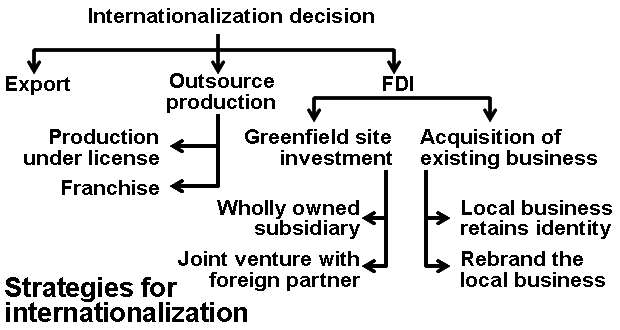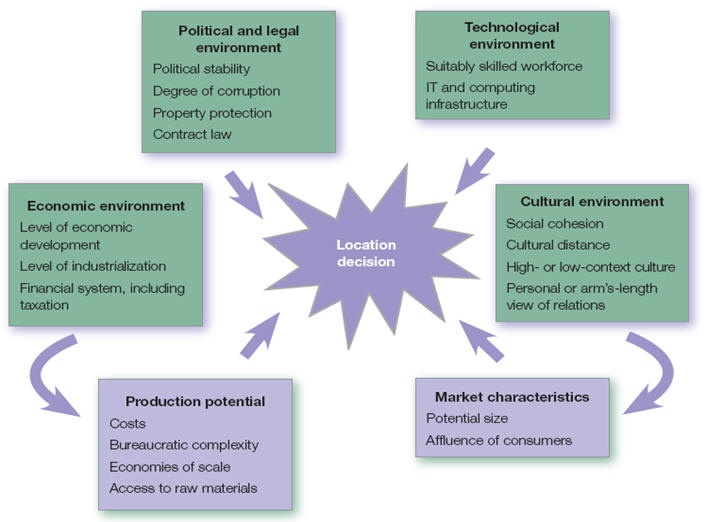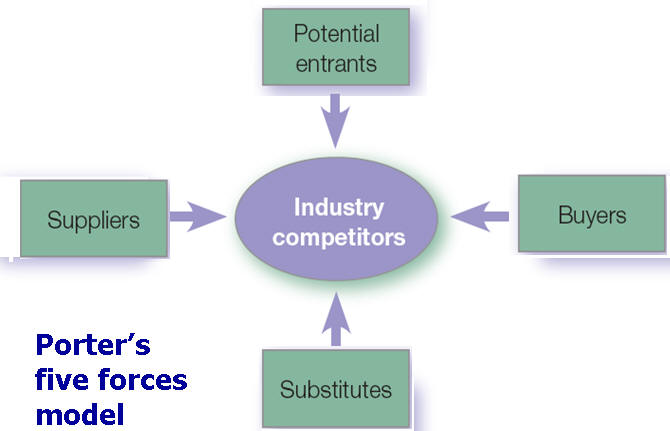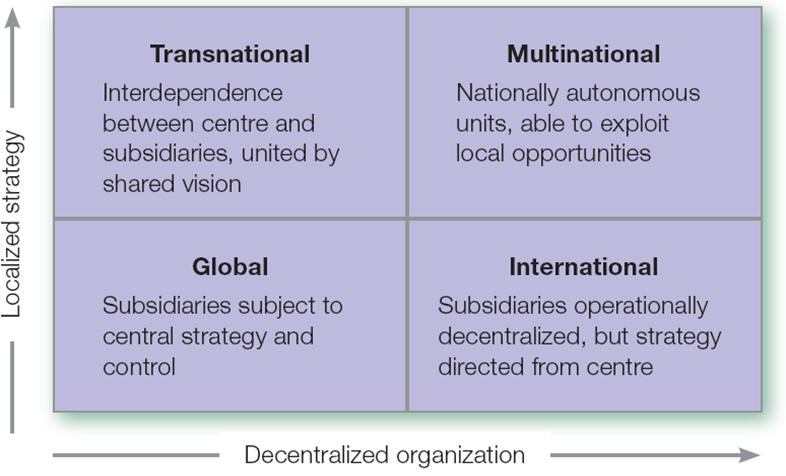Attractions of
developing countries (page 247)
Assume that you are a
manufacturer of consumer products such as mobile phones. Choose a
developing country and assess its attractiveness as
|
Whatever the country, the following points need to be covered.
|
Potential market for your products
-
Is there a growing middle class and
increasing demand for consumer products?
-
What competitors are in the country
already, serving the local market? Are these local or
global?
-
What hurdles are there at regulatory
level for the entry of new products?
|

|
|
Potential location for manufacturing your products |
-
Are there sufficient skilled workers
available for work in manufacturing?
-
Are transport and port facilities
adequate for your purposes?
-
Is economic development being managed
effectively, bringing a general rise in well-being in the
country?
-
Is there political stability in the
country? This need not imply that it is a democratic state,
but if there is an authoritarian government, is it one you
feel comfortable working with?
|
 |
|
Porter and globalization
(page 249)
Critically assess Porter's view of
global competitive advantage in terms of center-subsidiary
relations. Do you agree with Porter's recommendations for global
corporate strategy, and why?
|
|
 |
First, summarize how Porter
views competitive strategy globally. The MNE must choose the
best location for each aspect of its operations, depending on
the attributes of each country. Is he acknowledging the
importance of comparative advantage of differing countries?
Porter takes the view that the parent company determines global
strategy, and that subsidiaries in foreign locations exist to
serve the parent company’s goals, which include a fostering of
the company’s national identity. |
Many would probably disagree with this view of
parent-subsidiary relations, arguing that this is not the best way to
design a global corporate strategy. Possible reasons are:
-
Operations in a number of countries are bound
to be different in each, as each has its own cultural environment.
The parent company would be advised to accommodate and work within
the local culture, rather than impose its own culture, which might
be resented by local people.
-
The view of foreign subsidiaries looks rather
dated, as local subsidiaries are now more likely to be managed by
local people, rather than those sent from the parent company. Their
knowledge and skills in operating in the local environment equip
them to play a positive role in strategy formation, which can
ultimately aid the MNE parent’s executives.
|
Management implications of strategic
approaches (page 252)
Assess the differing approaches of
Porter's five forces model and the resource-based models of
competitive advantage in terms of their management implications and
organizational culture?
|
Core competencies represent an organization's collective skill and
learning in its specialist areas. Competency and/or the resource-based
models of competitive advantage
|
•According
to this model, competencies…
-
•can
be applied to a variety of products,
-
•yield
benefits to the end product which reaches the consumer
-
•are
difficult for competitors to imitate
•The
strategic implications
are:
-
•clear
goals needed to sustain leadership
-
•outsourcing
and alliance strategies downplayed
|
|
Porter’s model envisages dominance of the parent
company, both organizationally and culturally. Managers rely on a strong
corporate culture as a source of unity, binding the parent with
subsidiaries in different countries. Local managers carry out
instructions of the head office. The resource-based models view the
parent company’s role more as one of co-ordination. For Prahalad and
Hamel, technologies and skills exist across the company, in different
locations and business units. Management’s role is to coordinate them,
building the company’s competencies. They stress the crucial role of
central management in maintaining the core competencies.
It is probable, but not necessary, that you will
agree with these criticisms, but the theory is still highly influential
and, with modifications, is useful for cross-country comparisons.
|
An ideal model?
(page 257)
Assess the advantages of the global organization described by
Bartlett and Ghoshal. Which model is best-suited to the following
MNEs, assuming each has a presence in Europe, the Americas and Asia:
|
Assess the advantages of the global organization compared to the
transnational organization described by Bartlett and Ghoshal. |
The Bartlett and Ghoshal typology highlights differences in
multi-divisional structures according to whether the :
|
 |
|
The advantages of the global
organization rest with its centralized organization and control. This
type of company is not as vulnerable as decentralized companies to risks
in extended supply chains made up of different organizations, as it is
in a stronger position to control quality at each stage of production.
It is particularly suitable for mass-produced products with few local
variations.
Which model is best suited to specific MNEs?
Each of these MNEs is assumed to have a presence
in Europe, the Americas and Asia. There is probably no one best model
for each of these businesses. Much depends on cultural factors of the
national environment of the firm, and its historical background.
However, some recommendations can be made:
–
This company is likely to adopt the global model. Integration of
operations is needed, as is a global strategy. However, it should be
noted that oil companies operate in some difficult environments,
such as unstable developing countries, where managers must adapt to
local ways of doing things. Shell (featured in CS5.2) streamlined
its cumbersome organization in order to become more competitive. It
has also adapted to working in the difficult conditions in Nigeria.
A hypermarket retailer
– The
multinational model would probably be most appropriate. This is a
sector where local factors are important, and decentralized
organizations can respond to local needs and tastes. Distribution,
which is crucial in this sector, is typically handled by national
distribution networks, with which the retailer must work. It is
notable that Wal-Mart, which is closer to the global model, has
suffered setbacks in its internationalization from its strong
American base.
A television manufacturer
– This company
is likely to manufacture a range of consumer products in addition to
televisions. The transnational model is probably the best model.
This company is in a highly competitive sector, where the location
of production is crucial: companies seek proximity to large markets,
scale economies and cost reductions. Global strategy is needed, but
units bear considerable responsibility for management of operations.
A brewer
– Much consolidation has
occurred in the brewing industry. A few large companies, such as
AmBev, have grown by acquiring smaller brewers. The international
model or multinational model would be appropriate. The international
model is similar to a coordinated federation, with control from the
centre, but latitude for independent subsidiaries. The multinational
model is more decentralized, with more local autonomy and less
direction from the centre. Brewing is traditionally localized as a
business, emphasizing local brands and tastes. Although now
dominated by global companies, local markets remain important.
|
The flexible giant?
(Page 262)
The large MNE with dozens
of subsidiaries spanning all continents enjoys the advan-tage of
size, but its tendency towards bureaucracy and formal management may
be drawbacks to competitiveness. How can it use inter-organizational
networks to counterbalance these tendencies?
|
Inter-organizational networks can operate informally, cutting through
the procedural hurdles which are common in the large organization.
Interactions with other firms are central to managing supply-chain
links. The concept of the value chain has transformed international
production. The MNE becomes a co-ordinating organization, dealing with
firms in all stages of the supply chain. These links offer flexibility.
As they typically involve subcontractors, their services may be designed
for specific purposes and limited in time. The SME can play a role in
networks, offering specific specialist inputs which the large MNE may
lack. The networking approach is therefore flexible and adaptive.
However, the co-ordinating MNE must be vigilant to maintain core
competencies in-house. |
|
Inter-organizational networks
|
|
|
Click here to learn how De Beers control the world diamond market. |
Pop loses its fizz
(page 271)
Pop, a large MNE which manufactures soft
drinks and snacks, has found that its brands are being outsold by
rivals, including local brands, in many markets. It has always been
a highly centralized company, its product divisions designed for
global markets. Advise Pop's senior management on what changes you
would recommend in its strategy and organization, and how they
should implement them.
|
Strategy recommendations
-
Examine Pop’s portfolio of brands and products
critically. Which are the most successful in which markets?
Concentrate on the most successful and sell off the rest.
-
Examine the company’s markets. Which are
growing and which are stagnating? Emerging markets are now the
fastest growing, but they differ from country to country. In each,
local competitors will have established brands. Pop therefore needs
to target countries where its products and brands have the greatest
potential. Targeting individual markets implies adapting to local
preferences and designing marketing strategy accordingly.
-
Pop should evaluate its position in respect to
healthier alternatives to both its drinks and snacks, as these are
growing segments in all markets. Healthier snacks, with less salt
and fat, is a differentiation strategy which has potential and
offers consumers added value.
Organization recommendations
-
The global product divisions are proving
inflexible and unable to adapt to changing markets. The company
should consider regional divisions, with managers who can maximize
the potential of the products and brands in specific markets.
-
The company should probably decentralize
decision-making processes, to enable it to adapt to local
differences. The head office would maintain a co-ordinating role,
but responsibilities would be more shared than top-down.
How to go about implementing these changes?
These changes involve restructuring and changes in
roles and responsibilities. Such radical changes need to be managed from
the formal point of view, but they must be carried out with co-operation
of staff. This company has become accustomed to highly centralized
decision-making, and it will take time for staff to adjust to
decentralized responsibilities. Importantly, internal communication
needs to be more open, and communication with customers and other
stakeholders also needs to be improved. The centralized company tends to
be inward focused, which is partly why Pop has lost touch with markets.
|
What are the reasons behind the
success of Poland’s emerging MNEs since 1990?
First, highlight
the significance of Poland as a transition economy, including
liberalization, privatization and democracy. The changes have encouraged
business, including FDI. The reasons behind the success of Poland’s MNEs
since 1990:
-
Reduction in
red tape, bureaucracy and excessive regulation.
-
Growth in
numbers of entrepreneurs, as new opportunities emerged.
-
Desire of
start-ups to internationalize, attracted particularly by other
post-communist countries.
What tensions exist in the Polish social and political
environment?
Some which are highlighted in the case study:
-
Divide
between regions which have prospered from market reforms and those which
have not.
-
Large number
of unemployed people, and also a large number of people on state
benefits, including disability, unemployment and early retirement. The
generous system of welfare payments is a communist legacy, and
recipients are fearful that market reforms will cut back these programs.
-
Cultural
tension between traditional, nation-based values (associated with strong
Roman Catholic tradition) and more modern, secular values associated
with consumer market society.
-
Fragmented
political landscape, reflected in a wide range of parties. Shaky
coalition governments have become the norm, reflecting tensions between
parties which favor market reforms and conservative parties which are
skeptical of market reforms.
Asses the attractiveness of Poland as a destination for
FDI.
Poland is an
attractive destination for FDI despite significant drawbacks. The drawbacks
include bureaucracy and red tape. Poor infrastructure is also a problem.
Poland is a large country, and poor road and rail transport are obstacles
for investors. These drawbacks add to the costs of investing in Poland, but
if the attractions are overwhelming, they can compensate for the frustration
with procedures and infrastructure.
Poland’s
attractiveness stems from a number of features:
-
A strategic
location, well placed for serving Western European markets as well as
Central and Eastern European markets.
-
Large
population and rapidly-growing market for consumer goods and services.
-
Relative
political stability, despite political turmoil at party level.
-
GDP growth
rate has remained steady.
-
EU membership
from 2004 helped to encourage FDI (see Figure), and also promised
funding for infrastructure.
-
Government
led by the liberal Civic Platform Party under Donald Tusk is taking
steps to join the eurozone.
Assessing the overall picture, the potential investor would
probably agree that the advantages outweigh the drawbacks. But the
advantages depend partly on how future developments shape up, and how
competitive the location is in terms of costs for the potential investor.
Reducing bureaucratic red tape is urgent, as delays and administrative costs
reduce Poland’s attractiveness.
Weg Electric is competing in an industry, electric motors,
in which there are large, well-established global companies. As a Brazilian
company, it is an emerging MNE. Its main source of competitive advantage is
in its focus on customized products to suit customers’ needs. Also, it is
able to respond quickly to customers because it carries out most of its own
operations, including producing components. This strategy is one of
differentiation, offering a product and service which engenders customer
loyalty, making it less vulnerable to competition. Nonetheless, Weg has
internationalized, not so much to reduce costs as to be near to customers.
Its strength in R&D and training is possibly its most
important firm-based resource, because they feed directly into innovation
and product development. The company has not relied on outsourcing, and
therefore has greater control over manufacturing and sourcing than rival
companies, which are often caught up in disputes arising in managing these
relationships. Weg’s sense of self-reliance, part of its German cultural
heritage, is a firm-based resource and source of competitive advantage.






